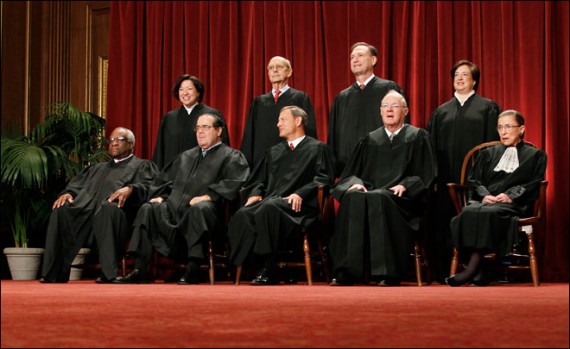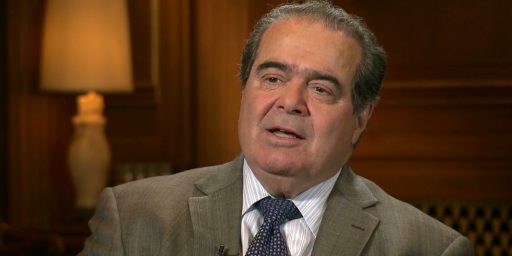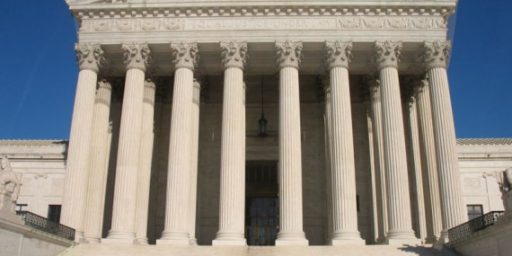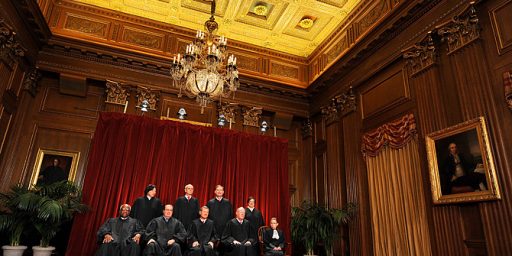Did Roberts Switch Vote on ObamaCare Ruling?
Either the majority and dissenting opinions in NFIB v. Sebelius were among the sloppiest in Supreme Court history or the Chief Justice switched sides at the 11th hour.
There’s some convincing speculation in the legal blogosphere that the unsigned dissent in NFIB v. Sebelius, which upheld most of the Affordable Care Act, was originally written by Chief Justice Roberts as the Court’s majority opinion. If so, it means that Roberts switched sides at the 11th hour.
Brad DeLong (an economist, not a lawyer) seems to have gotten the ball rolling when he asked, “DID NINO SCALIA FIRMLY THINK HE HAD HIS “CONSTITUTIONAL MOMENT”, AND HIS MAJORITY?” He notes,
Scalia refers to Ginsburg’s concurrence–agreeing with the Court that the mandate stands, but for different reasons than the opinion of the Court expresses–not as a concurrence, but as a ‘dissent’ . . . .
Repeatedly.
[…]
Nine times Scalia refers to Ginsburg’s opinion on the mandate not as a concurrence–agreeing with the result, but for different reasons–but as a “dissent”. An opinion that reaches the same result but by a different road is not a dissent. And there was not “a” dissent. There were three: Thomas’s, Ginsburg’s, and Scalia’s. When there are three dissents–two other dissents–to refer to one of them as “the” dissent is, at the least sloppy.
Is this deliberate–that Scalia wants us to know that his opinion was originally written to be the opinion of the Court? Or is this simply sloppy draftsmanship–chronic laziness at revision?
And what made Roberts peel off?
Inquiring minds want to know…
Deborah Pearlstein notes several related clues.
As a blogger or two have noted, the joint dissenting opinion by Justices Scalia, Kennedy, Thomas and Alito refers repeatedly to Justice Ginsburg’s opinion (most of which was also joined by Justices Kagan, Sotomayor, and Breyer) as a “dissent.” In the official court syllabus, Ginsburg’s opinion is called an opinion “concurring in part, concurring in the judgment in part, and dissenting in part.” Was this an error by the joint dissenters? Evidence that a majority of the Court had been planning to overturn the ACA, that the joint dissent was itself initially a majority opinion, and that Chief Justice Roberts’ vote changed at the last minute, leaving the Court to scramble to revise and correct all of its opinions (corrections it wasn’t fully successful in making)?
Well, maybe. Justice Ginsburg’s opinion goes both ways, so to speak. Still, it is a bit odd that the primary dissent refers to an opinion substantially concurring with the Court’s judgment as a “dissent,” rather than, say, a concurrence, or probably better given Ginsburg’s mixed conclusions, the “opinion by Justice Ginsburg.” Standing alone, I’d say curious, but perhaps not dispositive.
But then one might also note a few curious features of the dissent itself that one might be able to blame on hasty (re)drafting. The dissenters complain (Dissent Slip. Op., at 65) for example, that “[i]t should be the responsibility of the Court to … remind our people that the Framers considered structural protections of freedom the most important ones, for which reason they alone were embodied in the original Constitution and not left to later amendment.” By which the dissenters mean, I am confident, “the Constitution did not initially include a Bill of Rights at least partly because the Framers felt the enumeration of powers sufficed to restrain the Government,” (Opinion of Roberts, C.J., Slip. Op., at 3) which is precisely as Chief Justice Roberts puts it in the first paragraphs of his opinion. Did the dissenters just miss that part? Or were they upset the other justices didn’t join that piece of the Roberts opinion? Otherwise, given the prominent place this point is given, a bit hard to see their complaint.Likewise, note that one of the dissenters’ complaints about the Court’s reading of the mandate as a tax was that it created, in the dissent’s view, another complex constitutional question about whether the mandate was a “direct tax” (and if so, subject to other constitutional restrictions). Reading it this way, the dissent notes, doesn’t avoid a constitutional question at all (as Roberts argued it did) but rather substitutes one constitutional question (the statute’s legality under the Commerce Clause) for another (the statute’s legality under the direct tax clause). The majority of course has an answer for the direct tax problem as well. What’s the dissent’s complaint about that answer? That the majority resolves the direct tax issue “with inadequate deliberation.” (Dissent Slip. Op., at 64). Not inadequate explanation in the opinion, but – despite truckloads of briefs, 6 hours of oral arguments, and 3 months of post-argument time for discussion – inadequate deliberation. As Justice Souter would’ve said, passing strange…
Was there a last minute switch? Certainly wouldn’t be the first time such a thing happened in a major case (see, e.g., Planned Parenthood v. Casey – the 1992 decision many had anticipated would reverse Roe v. Wade). It may take a while, but someday, this part of the story we will actually know.
David Bernstein adds,
Reader Stuart Buck provides more detail as to why the dissent reads like a majority opinion (see also Deborah Pearlstein at Balkanization):
1. The dissent has a whole section on severability that is completely beside the point except on the assumption that the mandate had been struck down, and now “We” have to decide whether and what to preserve of the rest of the act now that the mandate is gone.
2. Notice also that his response to Roberts is tacked on at the end, rather than worked into the body of whatever he was writing (see page 64 of his dissent). For example, one would have expected Scalia to directly take on Roberts’ application of the Anti-Injunction Act, but his brief section on that act only mentions what “the Government” argues (see pages 26-28).
3. On top of that, Scalia’s sections on the Commerce Clause and the Medicaid Expansion are just as long or longer than what Roberts writes (Scalia wrote 16 pages on the Commerce Clause and 21 pages on the Medicaid Expansion, compared to Roberts’ 16 pages and 14 pages respectively). Yet Scalia never writes in the vein of saying, “I agree with the Chief Justice’s opinion, but write to add a crucial discussion of some complexity.” His analysis agrees with Roberts, and makes essentially the same points in “We” language. There’s no reason for Scalia to do this at such length, unless his opinion is what came first.
UPDATE: Ed Whelan notes a related theory: Roberts assigned the opinion to himself, and wrote most of what became the four-Justice dissent. He then switched on the tax issue, and the four dissenters adopted most of his original majority opinion as a dissent. This would explain why the dissent is unsigned. Other blogs are noting that Justice Ginsburg directs much of her ire at the Chief, which is the sort of things Justices do when they think they’ve lost someone’s vote, not when they are trying to keep a tenuous vote to uphold uphold the law in question on board.
Aside from the fact that we have no clue why Roberts might have switched, it certainly sounds likely that he did. I’ve been following the Court with some interest going back to undergrad ConLaw classes in the late 1980s and don’t recall this sort of sloppiness in any of the cases I’ve read. (Then again, I’ve only read a very select handful of the Court’s output, focusing on a few key issues of interest to political scientists.) Further, while it’s unsigned, key parts of the dissent appear to have been penned by Scalia, who’s nothing if not a wordsmith.
Bernstein speculates that Roberts made a shrewd political calculation:
I should note that I think the Supreme Court is a political body (which is not to say that its decisions are primarily motivated by partisanship or political ideology) and that one can expect that the Court’s rulings are affected by outside events. As I noted long ago, the challenge to the individual mandate would have stood no chance if the president and the ACA were riding very high in the polls, as the Court would not have had the political wherewithal to write what would be seen as a radical opinion invalidating a popular law from a popular president. Similarly, the level of heat defenders of the ACA were giving the Court could have persuaded Roberts that discretion was the better part of valor. (By contrast, for example, historians seem to think that FDR was relieved that the Supremes removed the NIRA albatross from his neck.) Perhaps, as Rick Hasen suggests, he’d rather save his political capital for the affirmative action and voting rights cases that are coming up, especially since he found a way to give the “right” a partial victory in his commerce clause reasoning, and to limit the Spending power.
Hasen (who doesn’t join in the switch debate, merely seeks to explain Roberts’ vote with the liberal majority) speculates:
Roberts cares much more about the institutional legitimacy of the Court and elite public opinion than the other Justices. Larry Solum rightly remarks that it would have been a tectonic shift for the Court to have struck down such a major federal law, especially when the (original) expectations of almost all Court scholars of all political stripes was that the Court’s precedents made this an easy case to sustain the mandate.
Solum’s piece is worth a read, too, for an overview of legal theory but is rather far afield for our purposes here. If this speculation is correct—and, again, I emphasize that it’s all it is, even though it’s speculation with some strong circumstantial evidence to support it—it’s a perfectly reasonable move on Roberts’ part. While the judiciary is supposed to be above partisan politics, it’s absolutely a political institution. Not only does it tend to “follow the election returns,” but its power rests on public legitimacy and the deference of the much more powerful elected bodies. While I disagree with the twists and turns in the majority opinion, the result is fundamentally conservative–deferring to the wishes of the people’s representatives in doing something they clearly have the power to do.
If indeed Roberts switched his vote, either out of political calculation or because he went from being slightly skeptical of the tax argument to favoring it during the crafting of the opinions, there’s another twist. Presumably, he would have switched at least a few days before announcing the decision, giving Scalia (or his clerks) ample time to clean up the dissent. At very least, there was time to do a search-and-replace. Was Scalia deliberately trying to send a signal that Roberts flipped?
To preempt that line of discussion, I’m not arguing that the decision would be less legitimate is Roberts flipped, merely that it would make an interesting side story.
UPDATE: As numerous commenters note, Orin Kerr offers a plausible counter-explanation: The decisions were complicated, rushed, and written with an eye to peeling off an additional vote. This is a simpler and, as I say, plausible explanation. My problem with that is that the Supreme Court is not an undergraduate student. Not only are they comprised of nine graduates of the country’s top law schools, most are also among the top legal minds the country has to offer. They also employ three clerks each, all of whom are the cream of the crop of recent graduates of top law schools. And they set their own schedules. If they aren’t ready to release their opinions, they can just grant themselves an extension without losing a letter grade for each day late. That, of course, is also true if Roberts changed his mind.
In any case, the sloppiness on what we all knew was going to be the most dissected case of the year is puzzling, indeed.







It is certainly possible and would explain some of the unusual sloppiness in the dissent. But as you point out, it certainly could habe been corrected, unless someone wanted to send a signal. However, if true, and combined with Scalia’s unusually forceful dissent in the Arizona case it might signal a Supreme Court that is extremely polarized and it is starting to show.
Scalia apparently walked into court looking very depressed. I wouldn’t be surprised if he was trying to lobby Roberts at the absolute 11th hour.
DeLong is reading too much (or not enough) into the word dissent:
Kennedy’s opinion states:
What follows is the discussion of the Commerce Clause issues in which Ginsburg’s opinion is the dissenting one. Ginsburg’s opinion is not described as a dissent when the tax issue is addressed.
My day-after response is that anything else would have been Kafkaesque. It is reassuring that, however they reached the decision, a change to the tax form is treated as a tax. The alternative would have been to call it a mangrove, or a coconut, or whatever the speaker wanted to call it. In that path lay madness.
It is obvious what happened here: Roberts was “persuaded” . The government, news media, candidates, economy: all under control of the international one world/socialist cabal.
@Loma:
You know, yesterday we quoted Tyler Cowen saying some harsh things about the poor. This is his comment today:
He suggests that you trust Roberts, and his “flip.”
That was weird. There was a Loma comment a minute ago.
“Aside from the fact that we have no clue why Roberts might have switched, it certainly sounds likely that he did.”
Orin Kerr is skeptical. Did Chief Justice Roberts Change His Vote? Perhaps Not.
Orin Kerr offers what strikes may as a simpler explanation, that there were multiple complex issues, and Roberts had a 5-4 tally on his left for one part and a 5-4 tally to his right for another. He worked hard to craft an opinion that would attract additional votes, but was running out time; his opinion did not get circulated in time for the other justices to respond to each other as they normally would. Link
Or one could just read sam’s quote.
People are drawing a false inference: Roberts switched, BECAUSE he was thinking politically.
He could equally have bought into the Commerce Clause argument, voted to overturn the ACA, but then got to thinking about the tax argument and decided (as quite a few folks had argued all along) that it was sufficient to uphold the Act. There’s nothing quite like thinking to change a person’s mind – it does happen.
Switches at the last minute aren’t unknown. The other notorious case involving a switch was Chakraborty, which legitimized patents on bioengineered organisms.
@Anderson:
Let me humbly suggest that most of those people believe this *had* to be political are engaging in projection.
Either they don’t like the decision or they don’t like the fact that Roberts is a conservative. And so they can’t believe that this can either be (a) an intellectually principled position (’cause the only good positions are conservative positions) or that (b) a conservative can possibly intellectually occupy a “non-conservative” position.
In the end, such beliefs tell us more about the intellectual flexibility of the people who express them than they do about the person and decision in question.
rehnquist would have struck this thing downnnn. he is not one to get bullied. on a side note, if the liberals dominated the court don’t ever think that they would switch sides.